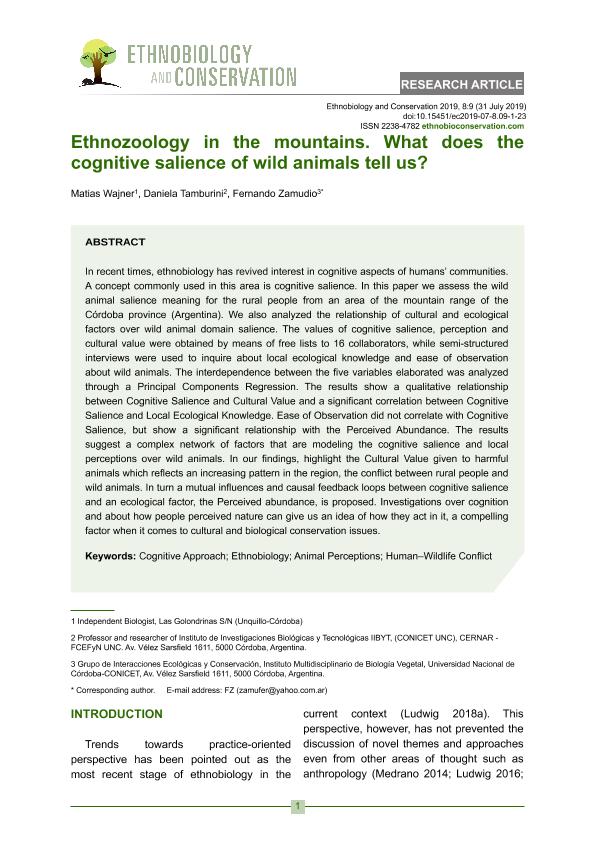Mostrar el registro sencillo del ítem
dc.contributor.author
Wajner, Matias
dc.contributor.author
Tamburini, Daniela Maria

dc.contributor.author
Zamudio, Fernando

dc.date.available
2020-09-25T22:09:35Z
dc.date.issued
2019-08
dc.identifier.citation
Wajner, Matias; Tamburini, Daniela Maria; Zamudio, Fernando; Ethnozoology in the mountains. What does the cognitive salience of wild animals tell us?; Universidade Federal Rural de Pernambuco; Ethnobiology and Conservation; 8; 8-2019; 1-23
dc.identifier.issn
22384782
dc.identifier.uri
http://hdl.handle.net/11336/114922
dc.description.abstract
In recent times, ethnobiology has revived interest in cognitive aspects of humans' communities. A concept commonly used in this area is cognitive salience. In this paper we assess the wild animal salience meaning for the rural people from an area of the mountain range of the Cordoba province (Argentina). We also analyzed the relationship of cultural and ecological factors over wild animal domain salience. The values of cognitive salience, perception and cultural value were obtained by means of free lists to 16 collaborators, while semistructured interviews were used to inquire about local ecological knowledge and ease of observation about wild animals. The interdependence between the five variables elaborated was analyzed through a Principal Components Regression. The results show a qualitative relationship between Cognitive Salience and Cultural Value and a significant correlation between Cognitive Salience and Local Ecological Knowledge. Ease of Observation did not correlate with Cognitive Salience, but show a significant relationship with the Perceived Abundance. The results suggest a complex network of factors that are modeling the cognitive salience and local perceptions over wild animals. In our findings, highlight the Cultural Value given to harmful animals which reflects an increasing pattern in the region, the conflict between rural people and wild animals. In turn a mutual influences and causal feedback loops between cognitive salience and an ecological factor, the Perceived abundance, is proposed. Investigations over cognition and about how people perceived nature can give us an idea of how they act in it, a compelling factor when it comes to cultural and biological conservation issues.
dc.format
application/pdf
dc.language.iso
eng
dc.publisher
Universidade Federal Rural de Pernambuco
dc.rights
info:eu-repo/semantics/openAccess
dc.rights.uri
https://creativecommons.org/licenses/by-nc-sa/2.5/ar/
dc.subject
ANIMAL PERCEPTIONS
dc.subject
COGNITIVE APPROACH
dc.subject
ETHNOBIOLOGY
dc.subject
HUMAN-WILDLIFE CONFLICT
dc.subject.classification
Otras Ciencias Biológicas

dc.subject.classification
Ciencias Biológicas

dc.subject.classification
CIENCIAS NATURALES Y EXACTAS

dc.title
Ethnozoology in the mountains. What does the cognitive salience of wild animals tell us?
dc.type
info:eu-repo/semantics/article
dc.type
info:ar-repo/semantics/artículo
dc.type
info:eu-repo/semantics/publishedVersion
dc.date.updated
2020-09-21T14:48:26Z
dc.journal.volume
8
dc.journal.pagination
1-23
dc.journal.pais
Brasil

dc.journal.ciudad
Pernambuco
dc.description.fil
Fil: Wajner, Matias. No especifíca;
dc.description.fil
Fil: Tamburini, Daniela Maria. Consejo Nacional de Investigaciones Científicas y Técnicas. Centro Científico Tecnológico Conicet - Córdoba. Instituto de Investigaciones Biológicas y Tecnológicas. Universidad Nacional de Córdoba. Facultad de Ciencias Exactas, Físicas y Naturales. Instituto de Investigaciones Biológicas y Tecnológicas; Argentina
dc.description.fil
Fil: Zamudio, Fernando. Consejo Nacional de Investigaciones Científicas y Técnicas. Centro Científico Tecnológico Conicet - Córdoba. Instituto Multidisciplinario de Biología Vegetal. Universidad Nacional de Córdoba. Facultad de Ciencias Exactas Físicas y Naturales. Instituto Multidisciplinario de Biología Vegetal; Argentina
dc.journal.title
Ethnobiology and Conservation
dc.relation.alternativeid
info:eu-repo/semantics/altIdentifier/doi/http://dx.doi.org/10.15451/ec2019-07-8.09-1-23
dc.relation.alternativeid
info:eu-repo/semantics/altIdentifier/url/https://ethnobioconservation.com/index.php/ebc/article/view/299
Archivos asociados
